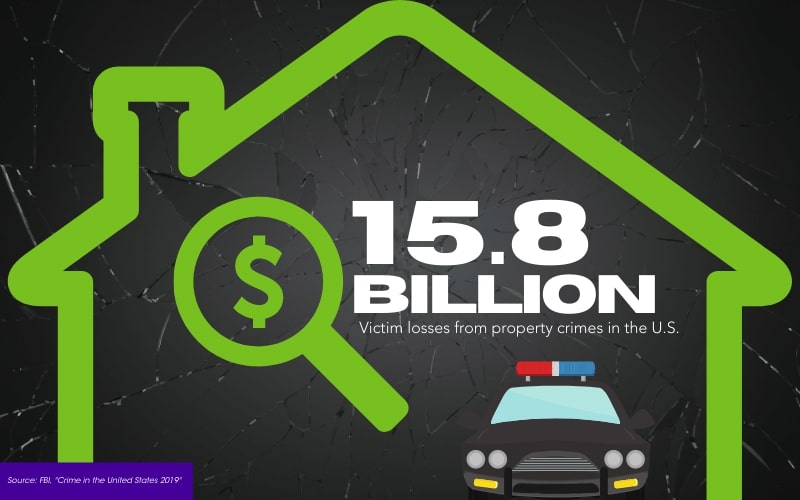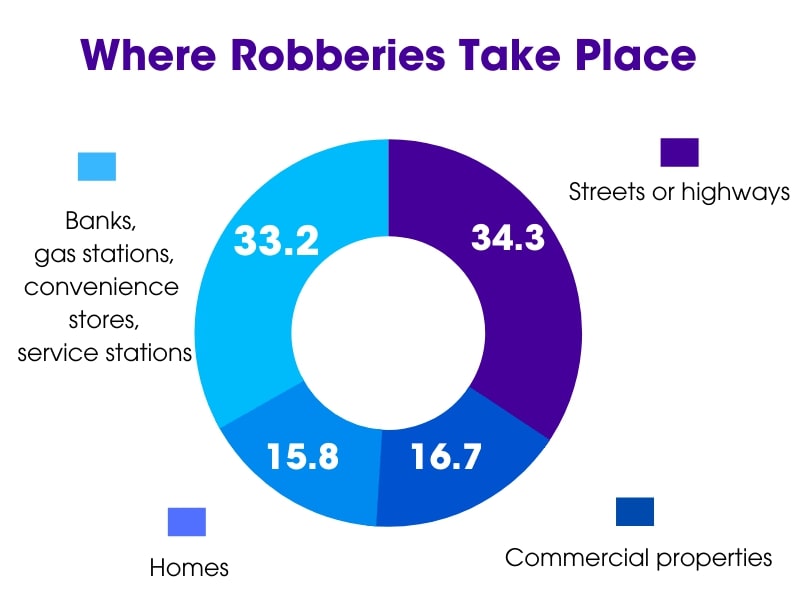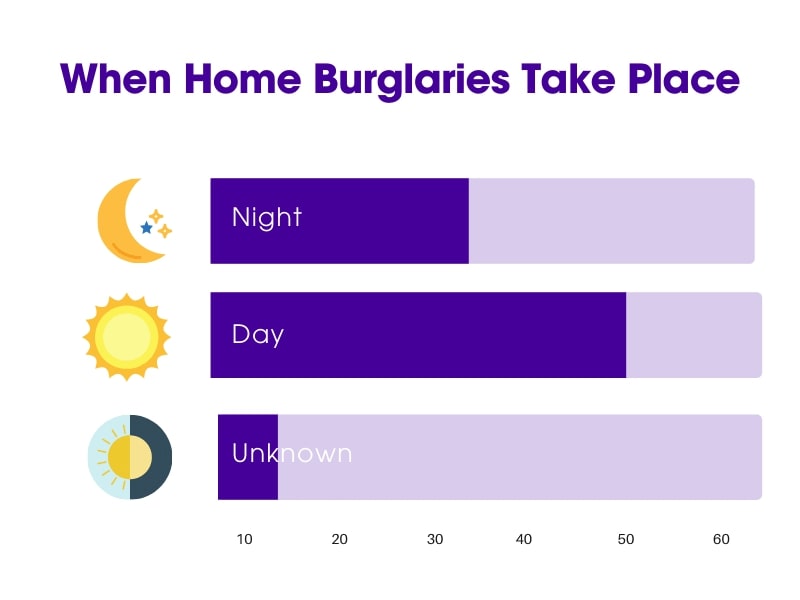You may have heard the terms “burglary” and “robbery” used interchangeably, but they aren’t the same. They have different criteria and may even overlap from time to time. In this post, we’ll define both burglary and robbery, explain the ways that they are similar and different, and provide important statistics about each.
Definitions and statistics will come primarily from from the FBI’s Uniform Crime Reporting (UCR) Program. Established in 1930, the UCR Program is a huge, nationwide, collaborative effort to gather crime data. More than 18,000 city, university and college, county, state, tribal, and federal law enforcement agencies are eligible to voluntarily report data on crimes. The main purpose of the program is to create reliable info on crime for law enforcement, but the data is now regularly sourced by a variety of people (including criminologists, the media, students, and sociologists). It’s a trustworthy and unique treasure trove of data for the state of crime in our country.
What is a property crime?
Burglary and robbery are both considered property crimes. Property crime includes the following offenses:
- Burglary
- Larceny-theft
- Motor vehicle theft
- Arson
Theft-type offenses involve the taking of money or property, but without force or threat.
What is burglary?
When you think about a burglar, you might be picturing someone cartoonish wearing all black and a mask. This bad guy then breaks into a home to steal cash or a flatscreen TV. But in fact, someone can be charged with burglary even if they didn’t steal a single thing.
The FBI’s Uniform Crime Reporting (UCR) Program defines burglary as:
“…the unlawful entry of a structure to commit a felony or theft. To classify an offense as a burglary, the use of force to gain entry need not have occurred.”
In other words, it’s entering someone’s property without permission, and with the intent to commit a crime — any crime (not just theft). What is considered a “structure” can be pretty broad. The FBI’s definition of structure includes an apartment, barn, house trailer or houseboat when used as a permanent dwelling, office, railroad car (but not automobile), stable, and vessel (i.e., ship).
Different states have different degrees or categorizations of burglary, but all require certain elements, spelled out by Nolo’s Plain-English Law Dictionary:
- entering
- a building
- without permission
- with the intent to commit a felony or steal property while inside (even if the theft itself would only be a misdemeanor).
Examples of burglary
Here’s a pretty typical example of a burglary:
Brad knows there is an expensive laptop in a single-family home on Birch Street. Brad breaks the lock on the backdoor, sneaks into the kitchen, swipes the laptop from the counter, and disappears out the same door.
Here’s a more unusual example, which is also considered a burglary:
Todd enters Ryan’s barn by walking in the open barn door, because he is planning to steal Ryan’s tractor. The tractor is not in the barn as Todd expected, so he just goes home. Even though Todd didn’t take the tractor, he has still committed burglary.
There are three subclassifications of burglary:
- Forcible entry – Physical force or serious threats to the occupants are used to gain entry. This can include smashing windows, slashing screen doors, or forcing the occupants out by threat or violence after having come in peacefully.
- Unlawful entry where no force is used – This category removes force as a required factor. This would be like the example above where Todd enters Ryan’s barn without force.
- Attempted forcible entry – A forcible entry is attempted, but not completed.
What is robbery?
The FBI’s Uniform Crime Reporting (UCR) Program defines robbery as:
“…the taking or attempting to take anything of value from the care, custody, or control of a person or persons by force or threat of force or violence and/or by putting the victim in fear.”
Just like burglary, states define robbery in different ways, but they all contain the same elements:
- taking money or property
- directly from someone
- without permission
- with the intent to keep the property permanently
- through the use of force or fear.
For a theft to be considered robbery, there must be a true threat or the use of force. If the property is taken from the victim, it’s considered a robbery. However, there doesn’t have to be actual violence or injury. The victim just needs to have an “actual and reasonable fear” based on the threats.
If a weapon is used, it’s called armed robbery, which is considered a more serious crime.
Examples of robbery
Here’s a typical example of a robbery:
Jill is approached rapidly on the sidewalk by Terri. Terri gives Jill a violent shove, sending Jill off balance while she snatches her purse and runs.
Remember, the threat of violence is key to defining robbery, even if the perception of the threat is different from reality. Here’s how this could work:
Tony is walking home from the store when Bill surprises him from behind. Bill tells Tony to give him his wallet. Tony, still with his back to Bill, feels something solid pressing into his upper back. Assuming that it’s a gun, and that Bill may shoot him if he refuses, Tony gives up his wallet. When Bill is caught by police, he swears that it was just his hand, and not a gun. But because Tony was terrified and truly believed his life was in danger, it’s considered a robbery.
If there was proof Bill had used a weapon or a gun, he could have been charged with armed robbery or aggravated robbery.
What are some differences between burglary and robbery?
Burglary and robbery have some similarities, but they are different in distinct ways.
For example:
- Larceny is always part of robbery, but not always part of burglary. Robbery may occasionally be referred to as larceny by threat or force. Larceny is defined as:
“…the unlawful taking, carrying, leading, or riding away of property from the possession or constructive possession of another.”
Larceny may happen during a burglary, but it’s not required for something to be considered a burglary.
Taking it a step further, according to Justia.com, we can distinguish robbery from larceny with two additional factors. For a robbery to occur:
1. The perpetrator uses force (or threats).
2. The crime happens in the victim’s presence.
- Robbery must occur in the victim’s presence.
Just like this distinguishes robbery from larceny, this factor also distinguishes robbery from burglary. Once again, consider the example above where Todd entered the barn without consent. Not only didn’t he take anything, but no one was even there to witness it. Still, a burglary occurred. On the contrary, a victim needs to personally experience the crime for a robbery to occur.
- Burglary involves entering a structure without permission to commit a crime. A robbery can occur in a park, a store, or on the sidewalk.
Things you might not know about burglary and robbery
- Burglary accounts for 16.1 percent of all U.S. property crimes in the United States.
- Property crimes resulted in losses estimated at $15.8 billion annually.

- Burglaries of residential properties accounted for 62.8 percent of all burglary offenses in 2019.
- Victims know their robbers in only about 26 percent of robberies.
- Robberies accounted for an estimated $482 million in losses.
- The average dollar value of property taken during burglaries was $2,661.
- The average dollar value of property taken during during robberies was $1,797.


Protect your home and family with home security
Worry and uncertainty about crime are things everyone faces from time to time; the true distinction is in the proactive steps we take to keep our world safe. Once you’ve educated yourself and your loved ones, it’s time to take action. Installing a smart home security system with video surveillance is a great example of a proactive step toward safety, and Guardian Protection is here to help.
If you’re interested in learning more about 24/7 professionally monitored home security, give us a call at 1.800.PROTECT (1.800.776.8328).

